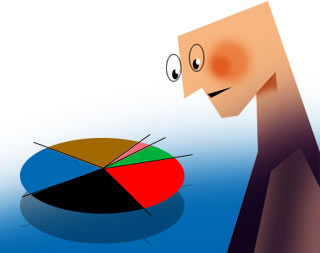|
|
| Help | |
| You are here: Rediff Home » India » Movies » Message Board |
|
| |||||||||||||||||||||||
|
| |||||||||||||||||||||||

Get Ahead presents the second of a three-part series on the Union Budget, especially designed for younger readers -- what it means, why the Budget is important and how it affects you and me!
Part I: The Budget? What is it?
 veryone talks about it.
veryone talks about it.
If they haven't, they soon will.
In the earlier article, you would have understood who brings out the Budget and why it is important.
Here, we will discuss key terms used in the Budget.
Where is the money kept?
Ever wondered where the government keeps all its money? Here's a look:
~ Consolidated Fund
All money raised by the government in whatever form is placed here.
These could be taxes, loans sanctioned or loans that were earlier given by the government, but are now repaid.
All government expenses are met with this account. No withdrawal can be made without Parliament's authorisation.
~ Contingency Fund
This money is only to be used for disasters and crises. This can be utilised by obtaining the President's permission.
~ Public Account
Money raised from various government schemes (provident fund and small savings schemes, for example) finds its way here.
Basically, when the government borrows from the public (takes money with an assured rate of interest), the money is kept in this account.
Since this money does not technically belong to the government for keeps (it has to return the money to the depositors some day), parliamentary approval for payment is not required.
What are the Revenue and Capital Budgets?
The Indian Constitution states that the government must distinguish between how much it spends on itself and how much it spends to create assets for the economy.
~ Revenue Budget
Revenue spending (revenue expenditure) takes place from this budget.
Salaries of government employees and military staff, perks for ministers, office furniture, grants to state governments, subsidies, interest to be paid on loans taken, and pensions for ex-defence staff are all accounted for here and referred to as revenue spending.
Any expenditure for the normal running of the government which does not lead to the creation of assets (see below), is called revenue spending.
This spending must be financed from revenue receipts, ie revenue that the government earns.
The government earns revenue in the form of taxes (corporate, income), duties (excise, custom), receipts, fees, interest and dividends (if the government makes investments).
~ Capital Budget
Capital spending (capital expenditure) refers to the money spent on creating assets (roads, highways, dams), buying land or building, purchasing machinery and equipment.
Loans from the Centre to various state governments or government-run companies are clubbed here, too. Also included are any investments made by the government in shares or other such instruments.
This spending is financed from capital receipts, the money that the government gets from loans. The loans can be from the public (market loans), from the Reserve Bank of India (the country's central bank), from foreign governments or international organisations like the World Bank.
Loans which the government earlier gave to other states or Union territories which are now repaid find their way here.
What is Plan and non-Plan expenditure?
Here's a note: non-Plan does not mean it was never planned.
The word 'Plan' here refers to the government's five-year economic plans.
The Planning Commission is responsible for coming out with plans every five years.
The Commission is also responsible for assessing the resources of the country, the need of the country and the direction the country should move in. So the plans it formulates must allocate resources efficiently, depending on the priorities set.
The first Five Year Plan was launched in 1951 and Jawaharlal Nehru was the first chairman of the Planning Commission. Currently, the tenth Five Year Plan is on (2002-2007).
You can view the earlier Plans on the Planning Commission's web site.
All Plan and non-Plan expenditure fits into the above categories of revenue and capital expenditure.
~ Non-Plan expenditure: Consists of defence expenditure, interest payments, subsidies and grants to states. It can be divided into revenue spending and capital spending.
~ Plan expenditure: Consists of pension, salaries and subsidies. This, too, can be divided into revenue spending and capital spending (though the bulk is revenue spending).
Once you understand these terms, you will be able to figure out the basic components and structure of the Budget.
Not quite rocket science, is it?
DON'T MISS!
- Part I: The Budget? What is it?
- February 4: How the Budget affects you
Illustration: Dominic Xavier
|
|
| © 2008 Rediff.com India Limited. All Rights Reserved. Disclaimer | Feedback |